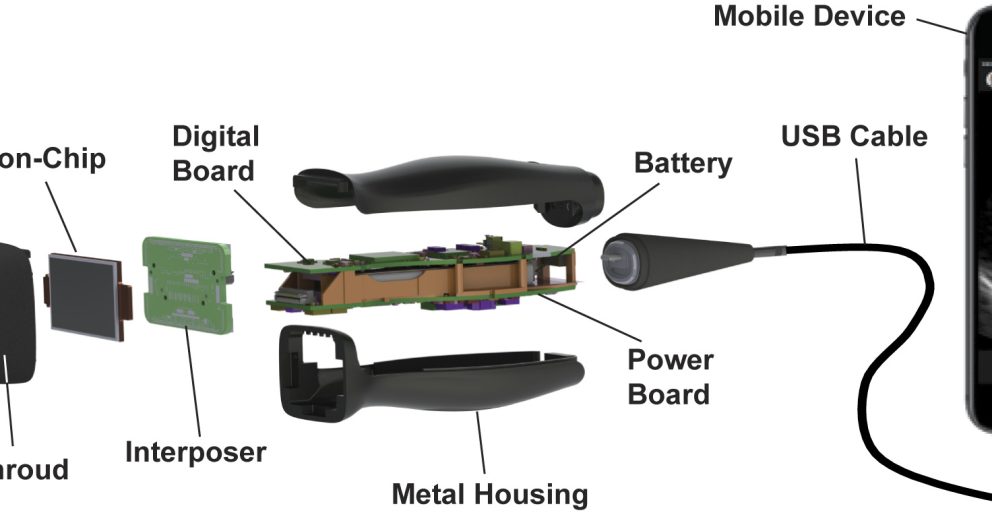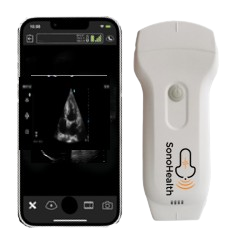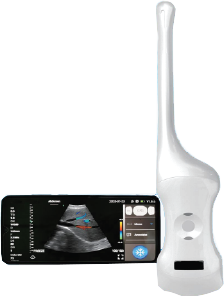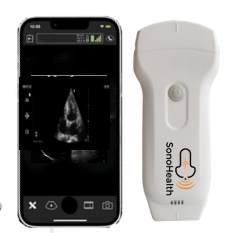The Evolution and Benefits of Wireless Ultrasound Technology
Introduction
The field of medical imaging has seen dramatic advancements over the last few decades, with ultrasound being one of the most widely used and accessible technologies in healthcare. Among the most notable innovations in recent years is the advent of
wireless ultrasound devices. These portable, compact, and highly versatile tools are transforming the way medical professionals diagnose and treat patients, offering significant improvements in accessibility, efficiency, and patient outcomes. In this article, we explore the evolution, benefits, and applications of wireless ultrasound technology and its potential to shape the future of medical care.
What Is Wireless Ultrasound?
Wireless ultrasound is a handheld medical imaging device that transmits ultrasound data to a smartphone, tablet, or computer via Wi-Fi or Bluetooth, eliminating the need for physical cables or bulky machines. These devices utilize cutting-edge transducer technology to capture high-resolution images and allow medical professionals to perform real-time imaging with minimal setup.
Unlike traditional ultrasound systems,
wireless ultrasound devices are compact, lightweight, and battery-operated, making them an ideal solution for both clinical and point-of-care applications. The images are displayed on connected devices, often using dedicated apps or software that allow advanced imaging features, including image storage, sharing, and real-time analysis.
The Evolution of Wireless Ultrasound Technology
Traditional Ultrasound Systems
Traditional ultrasound machines consist of a console with a screen, multiple probes, and various controls. These machines are often large, expensive, and stationary, making them suitable for hospitals but less ideal for remote or emergency applications.
The Push for Portability
With the increasing demand for portable medical devices, the first portable ultrasound machines emerged in the early 2000s. These devices were smaller and more convenient than traditional systems but still relied on physical cables to connect probes to the main unit.
The Rise of Wireless Ultrasound
The development of wireless communication technologies, such as Wi-Fi and Bluetooth, paved the way for the next evolution in medical imaging:
wireless ultrasound. Companies like GE Healthcare, SonoStar, Konted, and Butterfly Network introduced handheld wireless ultrasound devices that combine portability with cutting-edge imaging capabilities. These devices are designed to be user-friendly, affordable, and compatible with a range of operating systems, including iOS and Android.
Benefits of Wireless Ultrasound
1. Portability and Convenience
One of the most significant advantages of wireless ultrasound devices is their portability. These devices can fit in the pocket of a lab coat and be carried anywhere, making them ideal for use in:
- Emergency rooms
- Ambulances
- Remote clinics
- Disaster relief scenarios
The convenience of wireless ultrasound allows healthcare providers to perform imaging at the point of care, reducing the need to transport patients to imaging centers.
2. Cost-Effectiveness
Traditional ultrasound machines can cost tens of thousands of dollars, while wireless ultrasound devices are typically much more affordable. This cost reduction makes high-quality imaging accessible to smaller clinics, rural healthcare providers, and even individual practitioners.
3. Enhanced Accessibility
Wireless ultrasound devices can connect to smartphones or tablets, which are widely available and easy to use. This compatibility enhances accessibility, enabling medical professionals to perform imaging in underserved areas where access to traditional medical equipment is limited.
4. Real-Time Connectivity
The wireless nature of these devices allows for real-time image sharing and telemedicine consultations. Physicians can instantly share images with specialists for remote diagnosis, improving patient outcomes and reducing delays in care.
5. User-Friendly Design
Wireless ultrasound devices are designed with simplicity in mind. Many come with intuitive apps that offer features such as:
- Automated measurements
- AI-assisted diagnostics
- Image annotation and sharing
These features make it easier for non-specialists, such as general practitioners or paramedics, to use the technology effectively.
6. Sterility and Infection Control
With no cables or bulky components, wireless ultrasound devices are easier to sterilize. This feature is particularly important in environments where infection control is a priority, such as operating rooms or during pandemics.
7. Battery Life and Durability
Modern wireless ultrasound devices are equipped with long-lasting batteries, allowing for extended use in the field. Many devices are also rugged and designed to withstand harsh conditions, making them suitable for outdoor or emergency use.
Applications of Wireless Ultrasound
Wireless ultrasound technology has a wide range of applications across various medical fields. Here are some of the most common uses:
1. Emergency Medicine
In emergency situations, time is critical. Wireless ultrasound allows paramedics and emergency physicians to quickly assess patients for conditions such as:
- Internal bleeding
- Cardiac abnormalities
- Fractures
This rapid imaging capability can guide immediate treatment decisions, potentially saving lives.
2. Point-of-Care Ultrasound (POCUS)
Wireless ultrasound is a cornerstone of
Point-of-Care Ultrasound (POCUS), where imaging is performed at the patient’s bedside. POCUS is used for:
- Abdominal assessments
- Vascular access guidance
- Lung imaging
- Cardiac evaluations
The portability and ease of use of wireless ultrasound make it an ideal tool for POCUS applications.
3. Obstetrics and Gynecology
Wireless ultrasound devices are increasingly used in prenatal care to:
- Monitor fetal development
- Perform routine pregnancy checkups
- Identify complications
Their portability makes them particularly useful for midwives or healthcare providers in rural areas.
4. Sports Medicine and Orthopedics
In sports medicine, wireless ultrasound is used to diagnose and monitor musculoskeletal injuries, such as:
- Ligament tears
- Muscle strains
- Joint abnormalities
The ability to perform imaging on-site helps athletes receive faster care and return to activity sooner.
5. Primary Care
General practitioners and family doctors use wireless ultrasound for routine examinations, such as:
- Detecting gallstones
- Assessing bladder volume
- Evaluating thyroid nodules
This integration of imaging into primary care enhances diagnostic accuracy and reduces the need for referrals.
6. Veterinary Medicine
Wireless ultrasound isn’t limited to human healthcare; it is also widely used in veterinary medicine for:
- Diagnosing injuries in animals
- Monitoring pregnancies
- Guiding procedures in large and small animals
The portability of wireless devices is particularly beneficial for veterinarians working in rural or field settings.
Leading Brands in Wireless Ultrasound in Bangladesh
Several companies are at the forefront of wireless ultrasound technology, offering innovative products that cater to different medical needs. Some of the leading brands include:
1. SonoHealth
A global leader in wireless ultrasound manufacturing,
SonoHealth offers durable and affordable devices that cater to a wide range of applications, from Head to Foot. It can perform multiple imaging functions and is compatible with both iOS and Android and Windows devices.
2. SonoStar
Known for its
US FDA, CE, and ISO certifications,
SonoStar is a trusted name in the wireless ultrasound market, offering devices with high image quality and advanced features. It can perform multiple imaging functions and is compatible with both iOS and Android and Windows devices.
3. Konted
Konted offers durable and affordable devices that cater to a wide range of applications, from emergency care to obstetrics. It can perform multiple imaging functions and is compatible with both iOS and Android and Windows devices.
4. GE Healthcare
GE’s is wireless ultrasound solution that combines portability with advanced imaging capabilities, making it a favorite among healthcare professionals.
5. Butterfly Network
The
Butterfly is wireless ultrasound devices. It offers a single probe that can perform multiple imaging functions and is compatible with both iOS and Android devices.
Challenges and Future Prospects
Challenges
While wireless ultrasound technology offers numerous benefits, there are still some challenges to address:
- Battery Limitations: Although modern devices have improved battery life, extended use in remote settings can still be challenging.
- Image Quality: While improving, some wireless devices may not yet match the image quality of high-end traditional systems.
- Learning Curve: Non-specialists may require training to fully utilize the features of wireless ultrasound devices.
- Connectivity Issues: Reliable Wi-Fi or Bluetooth connections are essential, and poor connectivity can hinder real-time imaging and data sharing.
Future Prospects
The future of wireless ultrasound technology looks promising, with ongoing advancements in:
- Artificial Intelligence: AI integration will enhance diagnostic accuracy and automate complex imaging tasks.
- 5G Connectivity: Faster data transmission will improve real-time image sharing and telemedicine applications.
- Miniaturization: Continued development will lead to even smaller and more powerful devices.
- Cloud Integration: Seamless storage and sharing of imaging data in secure cloud platforms will further enhance collaboration and accessibility.
Conclusion
Wireless ultrasound technology is revolutionizing the medical imaging landscape, offering unparalleled portability, affordability, and convenience. By empowering healthcare professionals with smart, connected tools, it enhances diagnostic accuracy, improves patient outcomes, and expands access to quality care.
As the technology continues to evolve, wireless ultrasound is set to become an indispensable tool in modern healthcare, bridging the gap between advanced medical imaging and accessibility. Whether in bustling urban hospitals or remote rural clinics, wireless ultrasound is truly bringing the future of healthcare to the palm of our hands.
There are several compelling reasons to purchase
smart medical tools—such as handheld wireless portable color Doppler ultrasound devices—from
Unique Medi Trade:
1. High-Quality Products
- Unique Medi Trade provides cutting-edge medical imaging devices that meet international standards. Their tools often feature advanced features like wireless connectivity, portability, and color Doppler imaging.
- They partner with reputed brands, ensuring reliability and performance in the medical field.
2. Excellent Technical Support
- The company is known for its strong and responsive technical support team. Their team member all are qualified biomedical engineers.
- These professionals help with installation, training, and after-sales services.
3. Rapid Growth and Market Trust
- Unique Medi Trade has established a reputation for being dependable and customer-focused, contributing to their rapid growth in the Bangladeshi medical equipment market.
4. Competitive Pricing
- They offer high-value products at competitive prices, making advanced medical devices more accessible to healthcare providers.
5. After-Sales Service
- Beyond selling devices, they ensure long-term customer satisfaction with maintenance, repairs, and updates.
6. Convenience and Accessibility
- Their products, such as handheld wireless ultrasound machines, are ideal for point-of-care diagnostics. They are portable, user-friendly, and well-suited for various healthcare settings, including rural areas.
Would you like a detailed comparison of their products with competitors, or do you need more specific information about their offerings?
Please talk to expert: +880 1717 811 312






